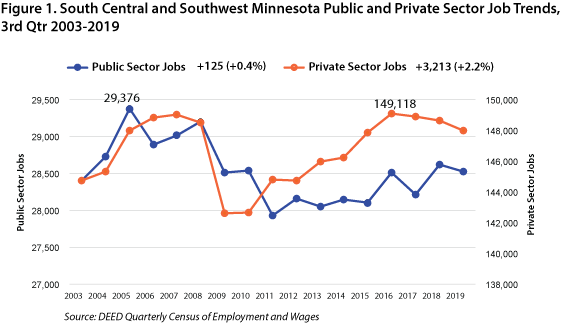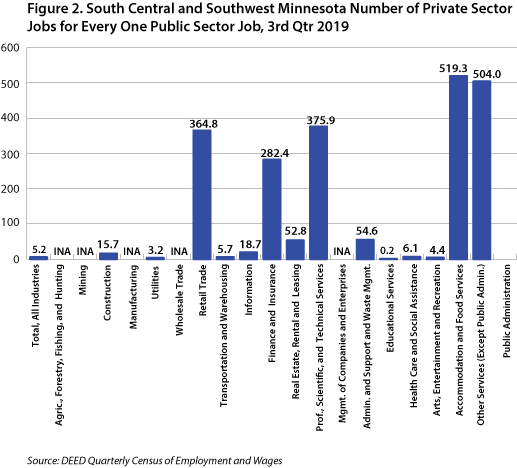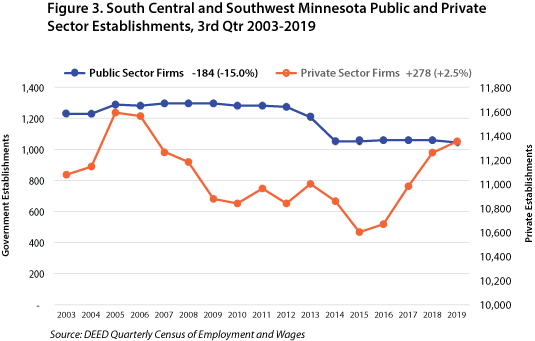by Mark Schultz
March 2020
Jobs in South Central and Southwest Minnesota can be broken down into two categories –public sector and private sector, and many, but not all, industry sectors are characterized by having both types of ownerships. The difference between the two is that the public sector is under governmental control whereas the private sector is run by individuals or companies. In the region 84 percent of jobs are in the private sector while the remaining 16 percent are in government, while government jobs in the total state make up 12 percent.
Over the years both public and private jobs in the South Central and Southwest region have seen somewhat similar trends. However, while the private sector saw an increase of 2.2 percent from the third quarter of 2013 to the third quarter of 2019, equaling over 3,200 more jobs, the public sector saw a smaller increase of only 0.4 percent or 125 more jobs.
Despite both public and private sectors having job increases over the years, there are some differences in these trends that are worth noting. Each sector saw their peak number of jobs 11 years apart, with the public sector seeing its peak of 29,376 jobs in 2005 while the private sector didn't peak until 2016 at 149,118 jobs. Each sector also saw their lows in different years, as the public sector bottomed out in 2011 while the private sector saw its lowest job count two years earlier in 2009, meaning the public sector started recovering from the recession later than the private sector. Since each sector began recovering from the Great Recession, public sector in 2011 and private sector in 2009, their respective rates of growth also varied. From 2011 to 2019 the rate of growth for the public sector rested at 2.1 percent, while the rate of recovery for the private sector from 2009 to 2019 was 3.8 percent. When we look at both sectors' recovery since 2011, however, the growth rates were very close at 2.1 percent for public sector and 2.2 percent for private sector. Since 2016, however, only the public sector saw overall growth, albeit minimal, to the tune of 15 additional jobs (0.05 percent) while the private sector saw a decrease of 1,140 jobs, a drop of 0.8 percent (see Figure 1).

As shown in Figure 2, private sector jobs are more dominant in certain industry sectors than others, including Finance and Insurance, Retail Trade, Professional, Scientific, and Technical Services, Other Services (Except Public Administration), and Accommodation and Food Services. For each of the aforementioned industry sectors, there were over 280 private sector jobs for every one public sector job in the third quarter of 2019, with Other Services (Except Public Administration) and Accommodation and Food Services seeing over 500 private sector jobs for every one public sector job. Note: There were no public sector jobs in Agriculture, Forestry, Fishing, and Hunting, Mining, Manufacturing, Wholesale Trade, and Management of Companies and Enterprises other than administrators of government programs, and no private sector jobs in Public Administration.

While many of the jobs in the Southwest and South Central region fall under the private sector (83.8 percent), certain industries have higher numbers of public sector jobs. Educational Services is the front-runner with 10,782 jobs being public sector jobs, which makes up over one-third of the total public sector jobs in the region. Public administration, in which all of the jobs are public sector, makes up an additional 37.3 percent of the total public sector jobs. Other industry sectors with higher numbers of public sector jobs include Health Care and Social Assistance (4,458 jobs) and Transportation and Warehousing (1,051 jobs). Thus, for those jobseekers who have a particular affinity towards working for the government, these may be avenues for them to pursue when looking at employment and educational opportunities (see Table 1).
| Industry Sector | Public Sector Jobs | Percent of Public Sector Jobs | Private Sector Jobs | Percent of Private Sector Jobs |
|---|---|---|---|---|
| Total, All Industries | 28,525 | 100.0% | 147,978 | 100.0% |
| Agriculture, Forestry, Fishing, and Hunting | 0 | 0.0% | 5,430 | 3.7% |
| Mining | 0 | 0.0% | 341 | 0.2% |
| Construction | 566 | 2.0% | 8,876 | 6.0% |
| Manufacturing | 0 | 0.0% | 32,304 | 21.8% |
| Utilities | 234 | 0.8% | 738 | 0.5% |
| Wholesale Trade | 0 | 0.0% | 7,713 | 5.2% |
| Retail Trade | 52 | 0.2% | 18,967 | 12.8% |
| Transportation and Warehousing | 1,051 | 3.7% | 6,042 | 4.1% |
| Information | 127 | 0.4% | 2,372 | 1.6% |
| Finance and Insurance | 21 | 0.1% | 5,931 | 4.0% |
| Real Estate, Rental and Leasing | 27 | 0.1% | 1,425 | 1.0% |
| Professional, Scientific, and Technical Services | 10 | 0.0% | 3,759 | 2.5% |
| Management of Companies and Enterprises | 0 | 0.0% | 1,409 | 1.0% |
| Administrative and Support and Waste Management | 76 | 0.3% | 4,152 | 2.8% |
| Educational Services | 10,782 | 37.8% | 1,700 | 1.1% |
| Health Care and Social Assistance | 4,458 | 15.6% | 27,400 | 18.5% |
| Arts, Entertainment and Recreation | 439 | 1.5% | 1,911 | 1.3% |
| Accommodation and Food Services | 24 | 0.1% | 12,463 | 8.4% |
| Other Services (Except Public Administration) | 10 | 0.0% | 5,040 | 3.4% |
| Public Administration | 10,644 | 37.3% | 0 | 0.0% |
| Source: DEED Quarterly Census of Employment and Wages | ||||
Despite the general increase in public sector jobs in the region, the number of employing firms has actually seen a decrease over time. As shown in Figure 3, the number of public sector firms was relatively stable from 2003 to 2012. For the next two years the public sector lost a total of 220 firms, primarily in Public Administration, for a drop of 17.3 percent. After that the establishment count remained stable again for the next five years. In all, the public sector lost a total of 184 firms from 2003 to 2019, a decrease of 15 percent.

Conversely, the number of employing establishments in the private sector saw many ups and downs during this time period, peaking in 2005 with 11,595 firms, before starting a generally declining trend and seeing its lowest count (10,600 firms) in 2015. Since then the private sector has enjoyed a steady increase in the number of firms ending with a 2019 count of 11,358 firms. Overall, unlike the public sector, the private sector saw an increase of establishments resulting in an additional 278 firms, an increase of 2.5 percent.
Across all industries, both the public and private sectors have seen an increase in average annual wages over the years, with the rate of growth being slightly higher among public sector wages (+70.8 percent) than the private sector jobs (+65.0 percent). Monetarily, this has equaled an increase of almost $20,000 per year for the public sector wages and almost $15,600 for the private sector. Additionally, average annual wages for the public sector have consistently been higher than those of the private sector across all industries, with differences ranging from 6.0 percent in 2014 to 22.6 percent in 2009 (see Figure 4).

Despite the annual average wages for the public sector (across all industries) being higher than those in the private sector, this is not always the case in specific industries. As shown in Table 2, there were six industry sectors in which jobs in the private sector paid more than those in the public sector, including construction, utilities, retail trade, real estate, rental and leasing, and professional, scientific, and technical services. These differences ranged from $676 for professional, scientific and technical services to over $20,600 for utilities. Among those industry sectors in which the public sector paid higher wages, the differences ranged from $3,224 for transportation and warehousing to almost $53,000 for finance and insurance.
| Industry Sector | Public Sector Average Annual Wage | Private Sector Average Annual Wage | Dollar Difference | Percent Difference |
|---|---|---|---|---|
| Total, All Industries | $48,152 | $42,120 | $6,032 | 14.3% |
| Agriculture, Forestry, Fishing, and Hunting | N/A | $41,496 | N/A | N/A |
| Mining | N/A | $63,908 | N/A | N/A |
| Construction | $55,172 | $56,108 | -$936 | -1.7% |
| Manufacturing | N/A | $51,948 | N/A | N/A |
| Utilities | $69,992 | $90,636 | -$20,644 | -22.8% |
| Wholesale Trade | N/A | $62,972 | N/A | N/A |
| Retail Trade | $13,832 | $25,272 | -$11,440 | -45.3% |
| Transportation and Warehousing | $42,380 | $39,156 | $3,224 | 8.2% |
| Information | $33,748 | $45,188 | -$11,440 | -25.3% |
| Finance and Insurance | $114,140 | $61,204 | $52,936 | 86.5% |
| Real Estate, Rental and Leasing | $23,192 | $28,132 | -$4,940 | -17.6% |
| Professional, Scientific, and Technical Services | $57,512 | $58,188 | -$676 | -1.2% |
| Management of Companies and Enterprises | N/A | $80,600 | N/A | N/A |
| Administrative and Support and Waste Management | $57,200 | $37,128 | $20,072 | 54.1% |
| Educational Services | $49,556 | $38,428 | $11,128 | 29.0% |
| Health Care and Social Assistance | $57,044 | $41,288 | $15,756 | 38.2% |
| Arts, Entertainment, and Recreation | $33,956 | $13,520 | $20,436 | 151.2% |
| Accommodation and Food Services | $11,284 | $14,196 | -$2,912 | -20.5% |
| Other Services (Except Public Administration) | $64,636 | $28,964 | $35,672 | 123.2% |
| Public Administration | $43,524 | N/A | N/A | N/A |
| Source: DEED Quarterly Census of Employment and Wages | ||||
Like anything else, there are benefits and drawbacks to working in both the public and private sectors. Some may argue that there is increased stability, flexibility, and work-life balance in the public sector (Roberts 2019), while others posit that advancement prospects and opportunities to work on "cutting-edge projects" are more plentiful in the private sector (Stewart 2019). Southwest and South Central Minnesota's workers may find themselves preferring employment in one sector over the other. Luckily, the region offers many opportunities to obtain employment in both the public and the private sector.
Sources: Roberts, Michael. 2019. "The Pros and Cons of Working for the Government." Retrieved April 10, 2020
Stewart, David. 2019. "The Advantages and Disadvantages of Private Sector Work." Retrieved April 10, 2020